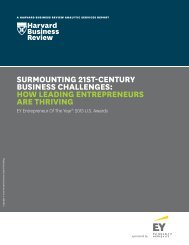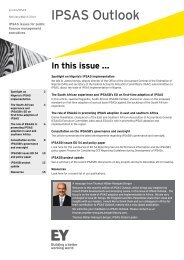Africa 2030: Points of viewLeap Frog: Infrastructural Development on the Road to the FutureJay IrelandJay Ireland is President and CEO of GE Africa. GE is one of the world’s largest and most admiredcompanies, and has had a presence on the African continent since 1898.What will Africa’s infrastructure look like in 2030?In order to answer this question, I regard it as necessary to lookback to 2000 to illustrate just how far the continent has alreadydeveloped. At that time, there were few companies willing to takea risk on establishing operations in Africa.However, GE, contrary to prevailing wisdom at the time, placed anearly bet on the continent by making investments across crucialsectors. To date, we have expanded our African footprint from anoriginal outpost in South Africa, to a network that extends acrossNigeria, Ghana, Angola, Kenya, Ethiopia and Mozambique. GE’sgrowth continues to accelerate with revenues now exceeding US$2.5 billion, up from US $1.7 million in 2012 and US $1.6 millionin 2011. We expect an even greater growth trajectory over the nextfew years.I was appointed President and CEO for GE in Africa in 2011 and,being based in Nairobi, swiftly became used to Sub-Saharan Africa’s‘new normal’: tremendous growth across a wide range of sectorsthat was, and continues to, have a profound impact on societies,industries and overall quality of life. I believe that the continuationof this growth to 2030 and beyond, will depend on Africa’s ability toinvest in the development of infrastructure.At present, infrastructure deficits remain a constraint acrossmuch of Africa. This is characterised by unreliable power supplies,difficulty in moving goods from one market to another and a lackof essential healthcare provision amongst other factors. But, atGE, we know that by engaging with governments and privatesectorpartners, we can support the development of infrastructureprojects in a manner that is ultimately an opportunity rather than arisk to our business.Take power as an important example of the transformative impactof infrastructure development.As the power sector of an economy increases, GDP follows suit. By2030, I predict that, across Africa, we will see new models withinthe power industry with more countries, such as Nigeria and Kenya,pursuing privatisation. With GDP growth in sub-Saharan Africaat an average of 6%, we need to see 12% growth within powersectors each year in order to meet demand and improve access toelectricity. I believe that, by 2030, we will see people buying andpaying for power on demand. Having stable electricity is the key tomanufacturing growth. Therefore, over the next decade, we shouldsee the results of our push to develop the power sector as a way ofdriving growth in different economies throughout the continent.By 2030 we should see intra-continental trade dramatically increaseabove the current rate of 11% – a continuation of a trend that isalready underway. There will be a stronger aviation industry, lessexpensive travel within the continent, a growing tourism industryand better logistics, while ports along the continent’s coastlinewill have expanded. The lack of transportation integration acrossthe continent will have been solved through collaborative andcreative approaches to financing projects, and a concerted effort tostreamline regulations and legislation.Africa’s healthcare sector should also look very different by 2030.In terms of technologies and access, we could start to see agreater level of public awareness and self-diagnosis, while mobiletechnologies will continue to have an impact on improving inclusionwithin the health sector.In fact, fifteen years from now the health industry could be largelydigital. Africa will have higher vaccination rates, better equippedfacilities and more highly trained healthcare professionals. By2030, new Millennium Development Goals will probably have beenintroduced but, at GE, our commitment to improving child mortalityand maternal health will remain and, we hope, will have played apart in improving the health of mothers and children throughoutthe continent.There are a number of key drivers of change which will ensure that,in fifteen years, countries will continue to have stable GDP growth.Many African countries will need to change from net exporters ofraw materials to exporters of finished products and services. Thiswill ensure that, in 2030, countries will continue to have stableGDP growth. Evidence of this change is emerging as infrastructuredevelopment grows to support manufacturing industries andencourage better conditions for doing business.50
The private and public sectors should work together to makesure that each occupies the right space, that each supports andfunds the right projects, and that the delineations between thetwo are maintained and transparent. While it is feasible for theprivate sector to obtain financing to support projects such aspower generation, governments also have a responsibility toparticipate, especially in difficult tasks, such as the developmentand construction of transmission lines. Governments need to knowwhere to invest directly, and where to let the private sector thrive.Empowerment of the entrepreneurial class is another crucialcatalyst for growth. Over the past five years, we have seenthe impact of entrepreneurship in addressing infrastructuraldeficiencies. Innovations that are being developed by Africansacross the continent are designed to suit the African context.The Off-Grid Energy Innovation Challenge run by GE across thecontinent in partnership with USADF and USAID, is designed tolend scale to such innovations. In Africa, we live in a culture ofmobile technology that simply does not exist to the same extent indeveloped countries –a kind of ‘leap frog’ innovation.Over the coming decades, GE will continue expanding into newmarkets on the continent as opportunities arise. We will growour business within those countries in partnership with hostcommunities through our broader impact on local supply chains,employment and manufacturing. In the next fifteen years, countriesworking to provide a good environment for investment, based ongood governance and rule of law, will see considerable progress.We should see even more progress in countries within sub-SaharanAfrica successfully practicing democracy with stable governmentsthat are committed to sustainable economic growth.Sixty per cent of Africa’s population is under the age of 35. We needto ensure that there will be jobs that meet their level of educationand skill set for this young and growing population over the comingdecades. We can achieve this, to a certain extent, by expandingour notion of work. In my experiences across the continent, I haveemphasised that strict ideas of employment and work do not alwaysapply in Africa.For example, I was recently in Tanzania for one of our corporatecitizenship initiatives, where I saw communities living, feedingand taking care of themselves through a small farm. We need tohonour and support that kind of work. We should not assume thatthose in rural areas are unemployed and living in poverty when, infact, more rural ways of living actually promote sustainability andeconomic growth across a broader base than that achieved throughpure industrial growth.Thinking back 15 years ago to the year 2000, it would have beenfoolish to think that it would soon be possible to use a cell phone tocheck your cholesterol level, or to buy life insurance. But, these arethe innovations that continue to make Africa, and the rest of theworld, different. There is very good reason to set high expectationsfor where Africa will be in 2030, as we already know that dramaticand rapid progress is possible.At GE, we will continue to invest in the continent’s infrastructureso that, fifteen years from now, growth is holistic, leading Africa toflourish through an entrepreneurial spirit that can transform thecontinent from within.Africa 2030: Realizing the possibilities51





